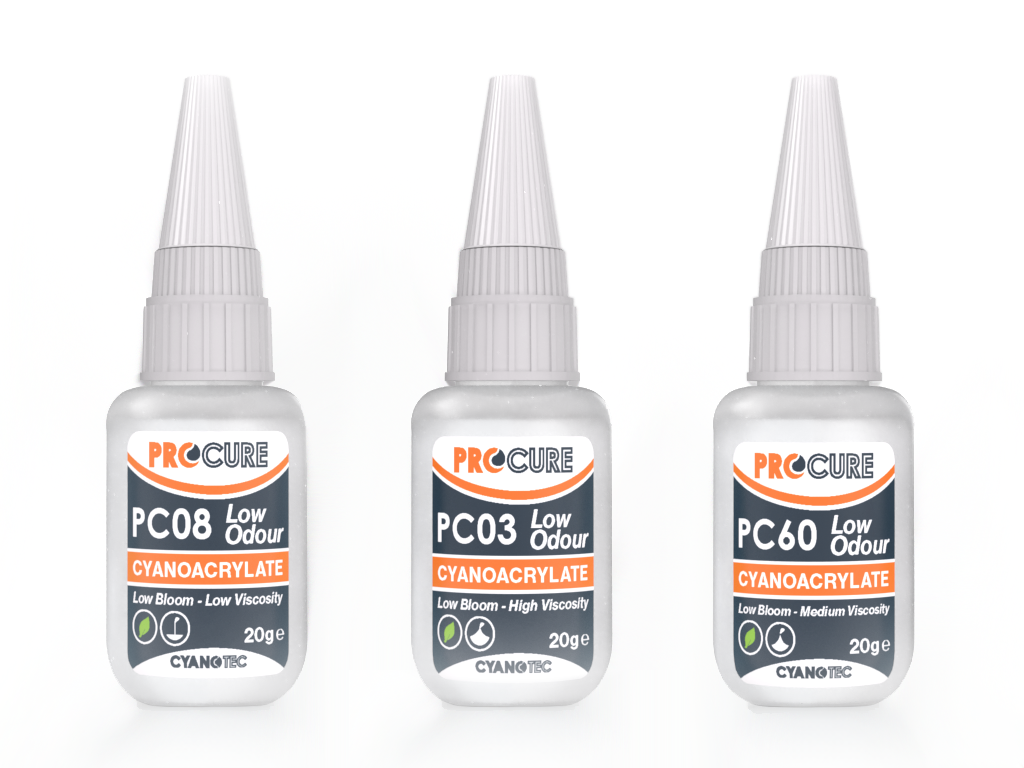
Blooming in Cyanoacrylate Adhesives
What is Blooming?
Blooming is a unique phenomenon that can occur with cyanoacrylate adhesives (CAs), resulting in a visible white or rainbow haze around the adhesive bond line. This is caused by the presence of unreacted cyanoacrylate molecules that become airborne and settle on the surface of the substrate. It is important to note that blooming is purely a cosmetic issue and does not affect the integrity of the bond. Other terms used to describe bloom are, frosting, bleaching, whitening and hazing.

Example of bloom appearing on the bond line of a hair brush.
Causes and Appearance of Blooming from Cyanoacrylate Adhesives
Blooming happens when unreacted cyanoacrylate molecules interact with surface moisture outside the bond line, creating a visible haze. This haze can appear as a rainbow effect when light hits the surface, caused by diffraction due to a small concentration of cyanoacrylate particles. Alternatively, a higher concentration of these molecules can result in a whitish haze. Blooming primarily occurs when adhesive is exposed from the bond line, allowing more airborne cyanoacrylate molecules to settle on the substrate. This is usually most visible on black and shiny surfaces.
Positive Effects of Blooming in Cyanoacrylate Adhesives for Latent Prints
In the 1970’s the Tokyo National Crime Lab’s forensic scientists concluded that the fumes released by cyanoacrylate adhesives (CA), react with the moisture found in hidden fingerprints. This reaction causes a resilient layer to form over the latent prints located on smooth surfaces, effectively preserving the detailed ridge pattern of the fingerprint.
This is known as the cyanoacrylate fuming method. The intricate ridge details of fingerprints on smooth surfaces, such as plastic, glass, finished, and unfinished woods, can be revealed through exposure to fumes from cyanoacrylate. Cyanoacrylate fuming, commonly known as the super glue method, is a chemical technique used for detecting hidden fingerprints.
During this process, the fumes interact with the hidden fingerprint’s traces of amino acids, fatty acids, and proteins, as well as the moisture in the air. This chemical reaction produces a visible, adhesive white substance that collects along the ridges of the fingerprint. The end result is a clear image of the hidden fingerprint, and at the same time, this reaction stabilises the ridge details, improving their preservation for potential future enhancements.
Mitigating Blooming Effects of Standard Cyanoacrylate Adhesives
To mitigate blooming, especially when aesthetics are a concern, there are several strategies that can be employed.
Minimise Fillets
Keep adhesive within the bond line to reduce exposure to open air and minimise the chance of blooming.
Use Low Odour/Low Bloom Products
Consider utilising cyanoacrylate products that have heavier molecules and reduced airborne tendencies. Cyanotec offers products like Procure PC03, Procure PC08, and Procure PC60, which have varying viscosities to suit different applications.

Blooming in Cyanoacrylate Adhesives can be mitigated by using Low Bloom and Low Odour products such as Procure PC03, PC08, PC60.
Avoid Large Fillets
Prevent excessive exposure of cyanoacrylate molecules to open air to reduce the likelihood of blooming.
Employ Post-Assembly Activators
Use activators to accelerate the curing of exposed adhesive, preventing the release of uncured cyanoacrylate molecules into the air. Cyanotec offers products like Procure PC750, Procure PC780, and Procure PC790, to suit different applications.
Ensure Adequate Ventilation
Promote cross ventilation to dissipate airborne cyanoacrylate molecules away from the bonded area, minimising the effects of blooming.
Consider Surface Sensitivity
Some substrates may have acidic surfaces that impede CA curing. Rinse such surfaces or choose adhesives and activators designed for those substrates to prevent blooming.
Optimal Environmental Conditions
Maintain relative humidity between 40 – 80% for ideal bonding conditions. Extreme humidity levels or temperatures can prolong the curing process, increasing the chances of blooming.
Avoid Extreme Temperatures
Elevated temperatures can induce blooming by driving off unreacted monomer from the adhesive.
Prevent Vacuum Environments
Vacuum environments can pull unreacted monomer from within the adhesive, leading to blooming.
Mind Product Expiry
Use cyanoacrylate products before their indicated use-by dates to ensure optimal performance and minimise the risk of blooming. Most standard cyanoacrylates have a shelf-life of around 12 months (Rubber toughened products may have a shorter, 6 month shelf life), this is due to the reactive nature of CA’s, this can be longer depending on how they are stored, for example cold storage.
By implementing these strategies, blooming can be effectively mitigated or eliminated, maintaining both the functionality and aesthetics of bonded parts.
 Adhesive Supplier
Adhesive Supplier